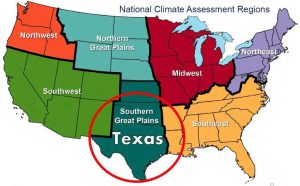Texas and Climate Change: No Climate Crisis in the Lone Star State
EXECUTIVE SUMMARY
This report will examine the scientific basis for claims of harmful effects from climate change in Texas. Assertions have been made that many areas around the world are experiencing negative impacts from unusual and unprecedented warming driven by increasing human emissions of carbon dioxide (CO2). Texas is no different. Promotion of the need to achieve “net zero” emissions is predicated on fear of existing and future devastating calamities resulting from CO2-enhanced warming.
The Fifth National Climate Assessment (NCA5) report (USGCRP, 2023) says that climate change is “putting us at risk from climate hazards that degrade our lands and waters, quality of life, health and well-being, and cultural interconnectedness.” The NCA5 report lists “warmer temperatures, more erratic precipitation, and sea level rise,” as well as “drier conditions” and “extreme heat and high humidity,” as the “climate hazards” affecting the Southern Great Plains, which encompasses the State of Texas (Figure 1).

Figure 1: National Climate Assessment Regions. USGCRP (2018)
In addition, Texas A&M University has published a Texas-specific report, Future Trends of Extreme Weather in Texas (Nielsen-Gammon et al., 2024), which warns of future harm to the citizens of Texas from man-made climate change. Predicted effects include increasing temperature, precipitation, drought, floods, storms, sea-level rise and wildfires.
Within this report, we analyze scientific data from various sources, including the National Oceanic and Atmospheric Administration (NOAA), the United States Environmental Protection Agency (U.S. EPA), the National Aeronautics and Space Administration (NASA), the United States Department of Agriculture (USDA) and reports published in peer-reviewed journals.
Based on these data, we arrived at the following key findings:
- The temperature in Texas has shown no unprecedented or unusual warming, despite
increasing atmospheric carbon dioxide (CO2). Recent temperatures in Texas are similar
to those found more than 100 years ago. - The annual number of 100 °F days in Texas has an overall decreasing trend.
- Texas has had a modest increase of 0.0245 inches per year of precipitation during 1850–
2023, which means that Texas is in no immediate danger of becoming drier. - Droughts in Texas are not becoming more severe or numerous.
- Tornadoes, hurricanes, and floods are not becoming more frequent in Texas.
- Sea-level rise and coastal subsidence are not threatening or inundating the Texan coast.
- Wildfires are not becoming more frequent or severe in the United States.
- Air quality in the United States is generally good and getting better.
- Agriculture in Texas is thriving.
- Carbon dioxide (CO2) is essential and beneficial for life on Earth, as CO2 greens the Earth
and more CO2 allows plants to grow bigger, produce more food and better resist
drought.
The evidence presented here is clear: there is no climate crisis in Texas. Not only is CO2 beneficial, but it is essential for life on Earth. Therefore, any measures for combating a purported climate crisis and for reducing CO2 emissions are not only unnecessary and costly but would also cause considerable harm to agriculture with no benefit.
Download the complete Texas and Climate Change publication here.
